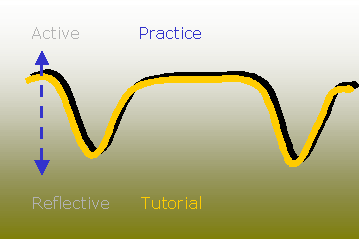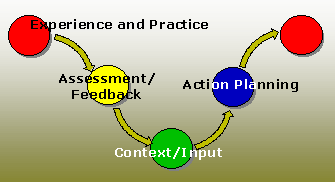Tutoring 1
Атэртон Дж (2008) “Теория Тьюторства” на Сироткин С Ф, Гребенкин Д Ю (Отв. Ред.) Тьюторское Сопровождение проектной и исследовательской и проектной деятельности в университете Удмуртский Государственный Университет Институт Развития Образования---or
Atherton J (2008) "The theory of tutoring" in S V Sirotkin and D U Grebenkin (eds.) Tutorial Support; project and research and development programme at the Udmurt State University Institute for Educational Development, Russia
For once, let's start from a common-sense position. Teaching has two bits: the presentation of new information on the one hand and getting people to learn it on the other. This paper is about "getting people to learn it". It is clear that the way in which material is presented affects whether or not or how people learn it, but that is not the present concern. For present purposes "tutoring" means "getting people to learn something".
The practice of teaching generally consists of moving between the two elements. Sometimes the process is clear:
"Henry VIII had six wives. The first was..." (new information)
"How long was Henry married to Katharine of Aragon?" (question to test knowledge, and to promote student activity and engagement with the subject-matter)
— and sometimes not so clear:
"This reaction is pretty inefficient. How might we improve it?" (Information leads to problem formulation)
"Increase the proportion of catalyst?" (Speculative answer based on thought processes
"Let's try it, then..." (Testing in real world)
Obvious or not, there is a continual movement between engagement with external ideas and information, and internal processing. Piaget called it "adaptation". It operates at a number of levels and on a "wheels within wheels" basis. In the figures below, I shall adopt the convention of the "external" world being at the top of the figure and the murky internal world of the learner being towards the bottom.
- Not all learning goes deeply into the internal world of the learner. Some of it — especially trial and error learning of motor skills — is continual activity and practice, and the "self-conscious" use of the mind hinders rather than helps (Claxton, 1998). Our immensely sophisticated processing of information about our golf swing takes place out of consciousness, and the big problem is the translation of feedback and advice from the coach, especially verbal, into bodily action.
- Some learning, however, is almost totally cerebral. It is a matter of manipulating representations of reality rather than reality itself — think of the problem-solving involved in deciphering a cryptic crossword clue, or mental arithmetic.
- I am trying to avoid the term "theory". "Theory" is easily juxtaposed with "practice", but it is not quite the same thing as the "reflection" I am referring to: as I have suggested some of the "practice" in this discussion may be to do with learning theoretical material. I shall treat "theory" as a body of knowledge existing "out there", as opposed to reflection which is that knowledge which we create anew for ourselves.
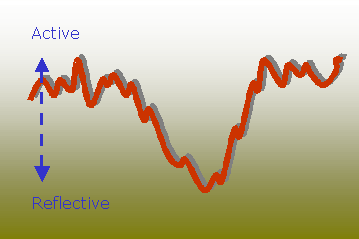
Figure 1
Teaching is concerned with the management of that learning process. Much of the time, we are our own teachers, because we manage our learning for ourselves, but this paper is addressed to people who have to manage it for others: it argues that the tutorial task — the "getting them to learn it" — is about promoting reflection, and stepping back from practice to do so.
Figure 2
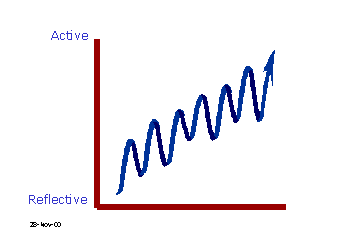
Figure 3
Readers familiar with the Kolb learning cycle will recognise the fit between that model and this one. They describe a movement between four points in the cycle:
- Concrete experience (CE)
- Reflective observation (RO)
- Abstract conceptualisation (AC) and
- Active Experimentation
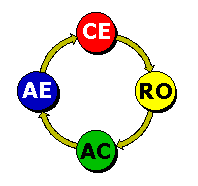
Figure 4
This model effectively pairs these stages off, emphasising:
|
This model |
Kolb |
|
|
Activity |
Active Experimentation and Concrete Experience |
(Public) |
|
Reflection/ |
Reflective Observation and Abstract Conceptualisation |
(Private) |
The simplification is not (on this occasion) to question the validity of the Lewin/Kolb cycle, but to adapt and develop it for the explication of tutorial practice.
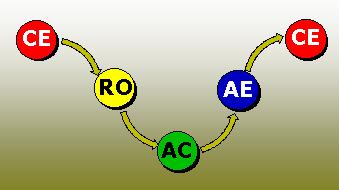
Figure 5
So: if you stretch out the cycle, over time, you get a picture like Fig. 5 above, and the fit, at the process level, with the tutorial model in Fig. 2 is quite marked.
How then does this translate into tutorial practice? (Remember that we are not looking exclusively at the one-to-one or one-to-small group "Oxbridge" tutorial, but at that part of teaching concerned with getting people to learn the material.) The mapping is actually very straightforward.
- Assessment: Stepping back from experience and practice is about reflecting on it sub specie the requirements—in other words assessing it and getting feedback on it.
- Contextualisation: Having feedback itself is not enough: "That was pretty awful, wasn't it? You need to do better next time!" does not really help. There needs to be some more specific account of why the assessment shows shortcomings. When tutoring, this stage may involve some process-oriented input or re-framing of the issue: "Look at it this way..."
- Action Planning: What are you going to do about it?
... and so back to the fray.
Figure 6
So the tutorial sequence may be:
- Students have been working on example sheets
- They bring them to class and they are marked
- They look at the ones they got wrong and the tutor helps them to see why
- They develop strategies for avoiding that pitfall in the future
- They take away more example sheets to work on
This process may of course be repeated for several topics within the same session.
It is easy to derive a simple protocol or agenda and a tutorial record sheet based on this pattern:
- New topic or matters arising from previous session
- Progress made or not made (latter is important)
- Topics discussed
- Plans/undertaking for next session
So far, so good: this has been a rather banal discussion of a way of working which most of us have arrived at anyway — but it does have some implications and variations which are worth exploring in the next section:
Atherton J S (2013) Doceo; [On-line: UK] retrieved from
Original
material by James Atherton: last up-dated overall 10 February 2013 
This work is licensed under a Creative Commons Attribution-Noncommercial-No Derivative Works 3.0 Unported License.
Search Doceo and associated sites:
![]() Save this on Delicious Tweet
Save this on Delicious Tweet
 Click
here to send to a friend
Click
here to send to a friend
This site is independent and self-funded. The site does not accept advertising or sponsorship (apart from what I am lumbered with on the reports from the site Search facility above), and invitations/proposals/demands will be ignored, as will SEO spam. I am not responsible for the content of any external links; any endorsement is on the basis only of my quixotic judgement. Suggestions for new pages and corrections of errors or reasonable disagreements are of course always welcome.

